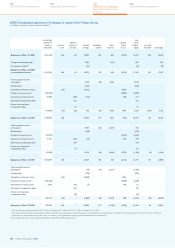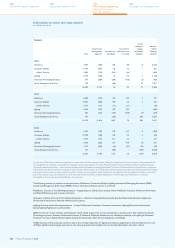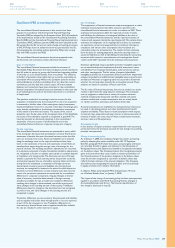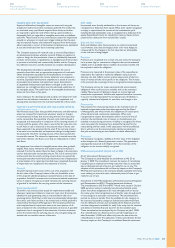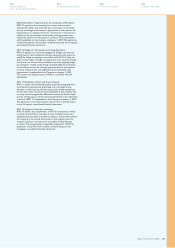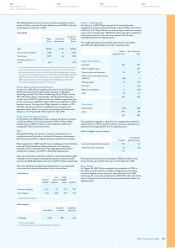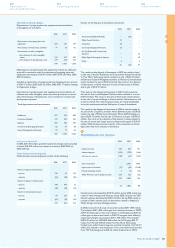Philips 2008 Annual Report Download - page 213
Download and view the complete annual report
Please find page 213 of the 2008 Philips annual report below. You can navigate through the pages in the report by either clicking on the pages listed below, or by using the keyword search tool below to find specific information within the annual report.
Intangible assets other than goodwill
Acquired definite-lived intangible assets are amortized using the
straight-line method over their estimated useful life. The useful lives
are evaluated every year. Brands acquired from third parties that
are expected to generate cash inflows during a period without a
foreseeable limit, are regarded as intangible assets with an indefinite
useful life. These brands are not amortized, but tested for impairment
annually or whenever an impairment trigger indicates that the asset
may be impaired. Patents and trademarks acquired from third parties
either separately or as part of the business combination are capitalized
at cost and amortized over their remaining useful lives.
The Company expenses all research costs as incurred. Expenditure
on development activities, whereby research findings are applied to
a plan or design for the production of new or substantially improved
products and processes, is capitalized as an intangible asset if the product
or process is technically and commercially feasible and the Company
has sufficient resources and the intention to complete development.
The development expenditure capitalized includes the cost of
materials, direct labor and an appropriate proportion of overheads.
Other development expenditures and expenditures on research
activities are recognized in the income statement as an expense as
incurred. Capitalized development expenditure is stated at cost less
accumulated amortization and impairment losses. Amortization
of capitalized development expenditure is charged to the income
statement on a straight-line basis over the estimated useful lives of
the intangible assets. The useful lives for the intangible development
assets are from three to five years.
Costs relating to the development and purchase of software for both
internal use and software intended to be sold are capitalized and
subsequently amortized over the estimated useful life of three years.
Impairment of non-financial assets other than goodwill, inventories
and deferred tax assets
Non-financial assets other than goodwill, inventories and deferred tax
assets are reviewed for impairment whenever events or changes
in circumstances indicate that the carrying amount of an asset may
not be recoverable. Recoverability of assets to be held and used is
recognized and measured by a comparison of the carrying amount of
an asset with the greater of its value in use and its fair value less cost
to sell. Value in use is measured as the present value of future cash
flows expected to be generated by the asset. If the carrying amount
of an asset is not recoverable, an impairment charge is recognized in
the amount by which the carrying amount of the asset exceeds the
recoverable amount. The review for impairment is carried out at the
level where discrete cash flows occur that are independent of other
cash flows.
An impairment loss related to intangible assets other than goodwill,
tangible fixed assets, inventories and equity-accounted investees is
reversed if and to the extent there has been a change in the estimates
used to determine the recoverable amount. The loss is reversed only
to the extent that the asset’s carrying amount does not exceed the
carrying amount that would have been determined, net of depreciation
or amortization, if no impairment loss had been recognized. Reversals
of impairment are recognized in the statement of income.
Goodwill
Goodwill represents the excess of the cost of an acquisition over
the fair value of the Company’s share of the net identifiable assets
of the acquired subsidiary/equity-accounted investee at the date of
acquisition. Goodwill is measured at cost less accumulated impairment
losses. In respect of equity-accounted investees, the carrying amount
of goodwill is included in the carrying amount of the investment.
Impairment of goodwill
Goodwill is not amortized but tested for impairment annually and
whenever impairment indicators require. In most cases the Company
identified its cash generating units as one level below that of an
operating sector. Cash flows at this level are substantially independent
from other cash flows and this is the lowest level at which goodwill is
monitored by the Board of Management. The Company performed
and completed annual impairment tests in the same quarter of all
years presented in the consolidated statements of income. A goodwill
impairment loss is recognized in the statement of income whenever
and to the extent that the carrying amount of a cash-generating unit
exceeds the recoverable amount of that unit.
Share capital
Incremental costs directly attributable to the issuance of shares are
recognized as a deduction from equity. When share capital recognized
as equity is repurchased, the amount of the consideration paid,
including directly attributable costs, is recognized as a deduction from
equity. Repurchased shares are classified as treasury shares and are
presented as a deduction from stockholders’ equity.
Debt and other liabilities
Debt and liabilities other than provisions are stated at amortized
cost. However, loans that are hedged under a fair value hedge are
remeasured for the changes in the fair value that are attributable
to the risk that is being hedged.
Provisions
Provisions are recognized if, as a result of a past event, the Company
has a present legal or constructive obligation that can be estimated
reliably, and it is probable that an outflow of economic benefits will
be required to settle the obligation.
Provisions are measured at the present value of the expenditures
expected to be required to settle the obligation using a pre-tax
discount rate that reflects current market assessments of the time
value of money and the risks specific to the obligation. The increase
in the provision due to passage of time is recognized as interest expense.
The Company accrues for losses associated with environmental
obligations when such losses are probable and can be estimated
reliably. Measurement of liabilities is based on current legal and
constructive requirements. Liabilities and expected insurance recoveries,
if any, are recorded separately. The carrying amount of liabilities is
regularly reviewed and adjusted for new facts and changes in law.
Restructuring
The provision for restructuring relates to the estimated costs of
initiated reorganizations that have been approved by the Board
of Management, and which involve the realignment of certain parts
of the industrial and commercial organization. When such
reorganizations require discontinuance and/or closure of lines of
activities, the anticipated costs of closure or discontinuance are
included in restructuring provisions. A liability is recognized for those
costs only when the Company has a detailed formal plan for the
restructuring and has raised a valid expectation with those affected
that it will carry out the restructuring by starting to implement
that plan or announcing its main features to those affected by it.
Guarantees
The Company recognizes a liability at the fair value of the obligation
at the inception of a financial guarantee contract. The guarantee is
subsequently measured at the higher of the best estimate of the
obligation or the amount initially recognized.
IFRS accounting standards adopted as from 2008
IAS 23 (Amendment) ‘Borrowing costs’
The Company has early adopted the amendment to IAS 23 on
January 1, 2008. The amendment removes the option of immediately
recognizing as an expense borrowing costs that relate to assets that
take a substantial period of time to get ready for use or sale. The
adoption of this amendment did not have any impact on the Company’s
IFRS financial statements as the Company already capitalizes borrowing
costs relating to assets that take a substantial period of time to get
ready for use or sale.
Amendments to IAS 39 Reclassification of Financial Instruments ‘Recognition
and Measurement’ and IFRS 7 ‘Financial instruments disclosures’
The amendments to IAS 39 and IFRS 7 which were issued in October
2008, permit an entity to reclassify non-derivative financial assets
(other than those designated at fair value through profit or loss by
the entity upon initial recognition) out of the fair value through profit
or loss category in particular circumstances. The amendment also
permits an entity to transfer from the available-for-sale category to
the loans and receivables category a financial asset that would have
met the definition of loans and receivables (if the financial asset had
not been designated as available for sale), if the entity has the intention
and ability to hold that financial asset for the foreseeable future.
These amendments were adopted by the Company on July 1, 2008.
Any reclassification of a financial asset in periods beginning on or
after November 1, 2008 took effect only from the date when the
reclassification is made. The application of these amendments did not
have any impact on the Company’s consolidated financial statements.
Philips Annual Report 2008 213
254
Corporate governance
250
Reconciliation of
non-US GAAP information
262
Ten-year overview
266
Investor information



